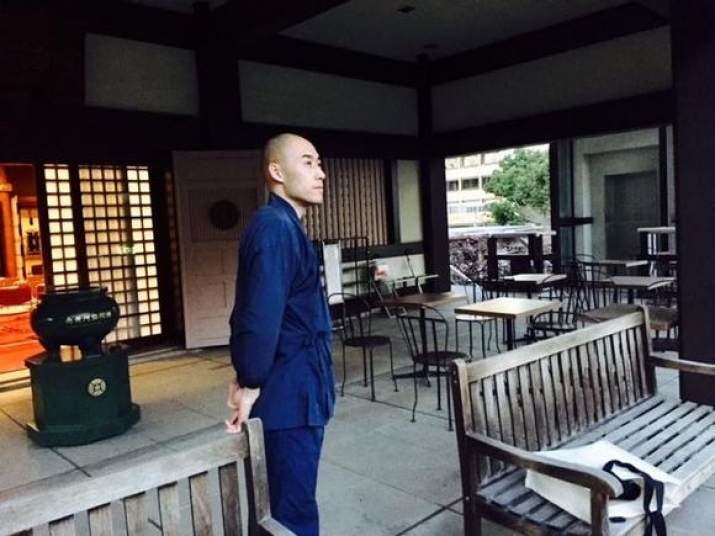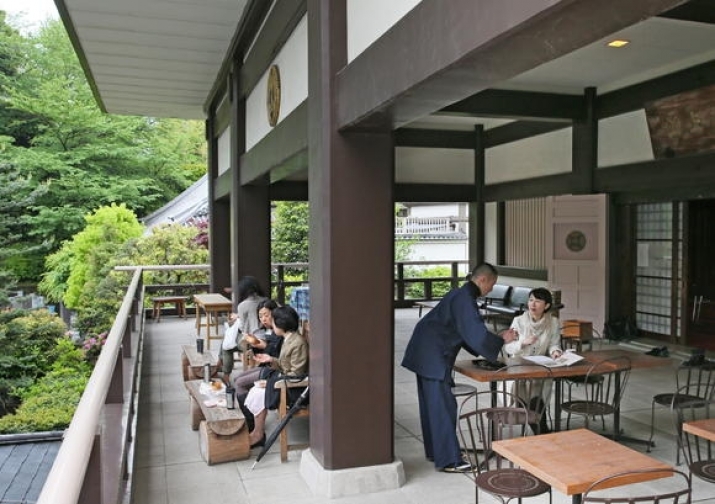NEWS
MBA Monk Aims to Rejuvenate Japan’s Buddhist Temples
 Shokei at Komyo-ji in Tokyo. Photo by Pallavi Aiyar. From asia.nikkei.com
Shokei at Komyo-ji in Tokyo. Photo by Pallavi Aiyar. From asia.nikkei.comAmid a marked decline in interest in Buddhism in Japan, 37-year-old Shokei Matsumoto, a monk from Komyo-ji, a temple in central Tokyo, wants to reverse that decline aand spread the Dharma in less traditional ways, by making Buddhist temples relevant to Japan’s overworked and aging population.
Although about 75 per cent of Japan’s 127 million people identify as Buddhist, most seldom see the inside of a temple except for during traditional ceremonies to mark the new year and funeral rites for deceased family members. “When people think of Buddhism they think of death, but what about life?” said Shokei, emphasizing that Buddhism should be about helping people to live a better life and awakening the Buddha nature within oneself. (Nikkei Asian Review, The Japan Times)
There have been recent warnings that Buddhism may be approaching something of a crisis point in Japan, with 27,000 of the country’s 77,000 Buddhist temples forecast to close over the next 25 years, reflecting shrinking populations in small rural communities and a loss of faith in organized religion among the country’s population as a whole. A survey carried out in 2015 by The Asahi Shimbun newspaper indicated that 12,065 Buddhist temples in Japan were without resident monks, representing 16 per cent of temples affiliated with the 10 most popular schools of Buddhism in the country. The survey also found that 434 temples from nine major denominations had closed completely in the past decade.*
Shokei also observed that many monastic communities are primarily focus on performing ceremonies and rituals for the public, rather than philosophical pursuits. “Temples should be a repository of our history and culture, passing the baton of our civilization’s foundations to future generations,” he said. (Nikkei Asian Review)
 The cafe at Komyo-ji was Shokei's first venture to help the temple maintain its financial footing and encourage more visitors. From asia.nikkei.com
The cafe at Komyo-ji was Shokei's first venture to help the temple maintain its financial footing and encourage more visitors. From asia.nikkei.comThe young monk recognized that temples funded solely by revenue from funeral-related services would need to adapt to Japan’s rapidly evolving social landscape in order to survive. “With so much social fragmentation, we needed to change our focus from families to individuals. And we could not take anyone’s loyalty for granted,” Shokei said. (Nikkei Asian Review)
Armed with an MBA degree from the Indian School of Business in Hyderabad, Shokei set about putting the wheel of change in motion, organizing seminars in temple management across Japan. He usually conducts six per year, and so far some 400 monastics have attended. At these training sessions, Shokei uses case studies of various Buddhist temples in the country as examples of alternative ways to draw lay Buddhists back to their local temples. Some of these non-traditional approaches to engaging with the community include hosting arts productions, such as theater and music, supporting volunteer activities, allowing temple stays, and offering meditation courses.
Shokei practices what he preaches, applying the same non-traditional approach to his home temple. On special occasions, Komyo-ji hosts events such as workshops, yoga classes, and concerts in the main prayer hall. Another of his ideas to connect the monastic community with the outside world is known as Otera Oyatsu Club (Temple Snack Club), which donates food offerings received by the temple to single-parent households.
“You don’t realize the true value of a temple until you connect with it for a long term. The longer you share your life with a temple, the more you start understanding its worth,” Shokei explained. “Temples were built around families, blood relations, and a sense of regional community. Today families and communities are collapsing, but people want to form bonds. I feel the need to create a new sense of community in an open, diverse society.” (The Japan Times)
Shokei, who was ordained in 2003 in Jodo Shinshu, a school of Pure Land Buddhism, is also the founder of Virtual Temple “HIGANJI,” one of the most popular websites for Buddhists in Japan. He has published more than five books in Japanese, some of which have been translated into other languages. He was nominated as a member of Young Global Leaders 2013 at the World Economic Forum in Davos.
“The world is changing, and there is no point in denying that fact,” said Shokei. “There’s a Buddhist concept that says all worldly things are transitory. A temple cannot stop time from passing, and it’s important that we accept what is and act accordingly.” (The Japan Times)
* Almost One-Third of Japan’s Buddhist Temples Expected to Close by 2040 (Buddhistdoor Global)
See more
Buddhist monk offers business advice to rejuvenate Japan's temples (Nikkei Asian Review)
Armed with an MBA, a Buddhist monk sets out to transform the future of the temple (The Japan Times)
Komyoji Temple
Related news from Buddhistdoor Global
Buddhist Temple in Tokyo Offers Graves for LGBT Couples
Japanese Priest Serves Up Pure Land Buddhism with Techno Beats
Japan Seeks World Heritage Status for Country’s Oldest Buddhist Pilgrimage Route
Buddhist Monks Extend a Helping Hand to Japanese Singles Seeking Romance
Buddhist Monks Are Only a Click Away in Japan
Related features from Buddhistdoor Global
Senso-ji: A Buddhist Temple for the People
Why Meditate?
The Buddhist Roots of Japanese Flower Arrangement
Spirituality as the Transformation of Daily Life: Living Buddhism in 21st Century Japan














